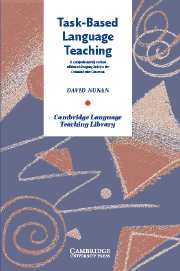Book contents
- Frontmatter
- Contents
- Acknowledgements
- Introduction
- Chapter 1 What is task-based language teaching?
- Chapter 2 A framework for task-based language teaching
- Chapter 3 Task components
- Chapter 4 An empirical basis for task-based language teaching
- Chapter 5 Focus on form in task-based language teaching
- Chapter 6 Grading, sequencing and integrating tasks
- Chapter 7 Assessing task-based language teaching
- Chapter 8 Tasks and teacher development
- Appendix A Approaches and methods – an overview
- Appendix B A unit of work based on the six-step procedure presented in Chapter 2
- Appendix C A unit of work based on the task/exercise typology in Chapter 5
- Appendix D Graded activities for the four macroskills
- Appendix E Common reference levels: self-assessment grid
- Glossary
- Index
Chapter 5 - Focus on form in task-based language teaching
Published online by Cambridge University Press: 16 February 2010
- Frontmatter
- Contents
- Acknowledgements
- Introduction
- Chapter 1 What is task-based language teaching?
- Chapter 2 A framework for task-based language teaching
- Chapter 3 Task components
- Chapter 4 An empirical basis for task-based language teaching
- Chapter 5 Focus on form in task-based language teaching
- Chapter 6 Grading, sequencing and integrating tasks
- Chapter 7 Assessing task-based language teaching
- Chapter 8 Tasks and teacher development
- Appendix A Approaches and methods – an overview
- Appendix B A unit of work based on the six-step procedure presented in Chapter 2
- Appendix C A unit of work based on the task/exercise typology in Chapter 5
- Appendix D Graded activities for the four macroskills
- Appendix E Common reference levels: self-assessment grid
- Glossary
- Index
Summary
Introduction and overview
The purpose of this chapter is to take a more detailed look at the place of grammar instruction within task-based language teaching. As we have already seen, the issue of whether or not a focus on form has a place in task-based language teaching is controversial. In the first section of the chapter, I will review several theoretical and empirical aspects of formfocused instruction that are of significance to TBLT. I will then expand on two of these: form-focused versus unfocused tasks, and consciousness-raising tasks. The sections that follow then focuses on an issue of central importance to syllabus designers and materials writers, which is where form-focused work should come in any task-based instructional cycle.
Theoretical and empirical issues
As we saw in Chapter 4, the place of a focus on form in TBLT is controversial. Some theorists adopt a ‘strong’ interpretation, arguing that communicative interaction in the language is necessary and sufficient for language acquisition, and that a focus on form is unnecessary. Krashen (1981, 1982), whose work was examined in detail in the preceding chapter, is one of the main proponents of this ‘strong’ approach. He argues that there are two processes operating in language development, subconscious acquisition and conscious learning, and that form-focused instruction is aimed at conscious learning which does not feed in to subconscious acquisition.
Another major issue for TBLT concerns the relationship between the task and the language that supports it or through which it is realized.
Information
- Type
- Chapter
- Information
- Task-Based Language Teaching , pp. 93 - 112Publisher: Cambridge University PressPrint publication year: 2004
